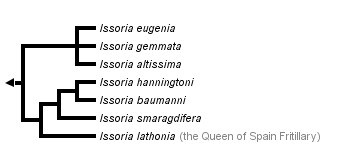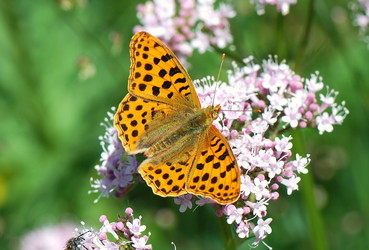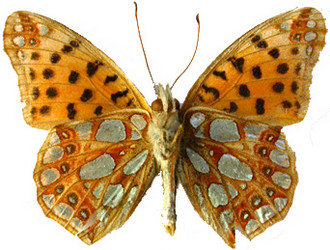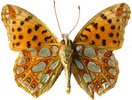Issoria
Prokuekenthaliella currently viewed as a subjective junior synonym, Afrossoria currently viewed as a subjective junior synonym
Niklas Wahlberg and Andrew V. Z. Brower


This tree diagram shows the relationships between several groups of organisms.
The root of the current tree connects the organisms featured in this tree to their containing group and the rest of the Tree of Life. The basal branching point in the tree represents the ancestor of the other groups in the tree. This ancestor diversified over time into several descendent subgroups, which are represented as internal nodes and terminal taxa to the right.

You can click on the root to travel down the Tree of Life all the way to the root of all Life, and you can click on the names of descendent subgroups to travel up the Tree of Life all the way to individual species.
For more information on ToL tree formatting, please see Interpreting the Tree or Classification. To learn more about phylogenetic trees, please visit our Phylogenetic Biology pages.
close boxIntroduction
Species of the genus Issoria are distributed throughout the Palaearctic and in parts of Africa. For a long period of time, species belonging to the South American genus Yramea were thought to belong to Issoria as well, but recent phylogenetic work (Simonsen 2006a, Simonsen et al 2006) has shown that this is not so.
Discussion of Phylogenetic Relationships
Species in the genus Issoria are found in three groups, the I. eugenia group, I. lathonia and the African I. smaragdifera group. Morphological studies (Simonsen 2006a, b) found that two of the African species (I. hanningtoni and I. baumanni) may not belong to Issoria. However, when molecular data were added to the analyses (Simonsen et al 2006), it was found that the African species (including I. smaragdifera) formed a clade within Issoria.
References
Simonsen, T. J. 2006a. The male genitalia segments in fritillary butterflies: Comparative morphology with special reference to the ’rectal plate’ in Issoria (Lepidoptera: Nymphalidae). European Journal of Entomology 103:425-432.
Simonsen, T. J. 2006b. Fritillary phylogeny, classification and larval hostplants: reconstructed mainly on the basis of male and female genitalic morphology (Lepidoptera: Nymphalidae: Argynnini). Biological Journal of the Linnean Society 89: 627-673.
Simonsen, T. J., N. Wahlberg, A. V. Z. Brower, and R. de Jong. 2006. Morphology, molecules and Fritillaries: approaching a stable phylogeny for Argynnini (Lepidoptera: Nymphalidae). Insect Systematics & Evolution 37: 405-418.
Title Illustrations

| Scientific Name | Issoria lathonia |
|---|---|
| Specimen Condition | Live Specimen |
| Source | Issoria lathonia 2 |
| Source Collection | Flickr |
| Image Use |
 This media file is licensed under the Creative Commons Attribution-NonCommercial-ShareAlike License - Version 2.0. This media file is licensed under the Creative Commons Attribution-NonCommercial-ShareAlike License - Version 2.0.
|
| Copyright | © 2008 YannickC |
| Scientific Name | Issoria lathonia |
|---|---|
| Location | Pic de Nore, Aude, France |
| Specimen Condition | Dead Specimen |
| Identified By | Niklas Wahlberg |
| Image Use |
 This media file is licensed under the Creative Commons Attribution-NonCommercial License - Version 3.0. This media file is licensed under the Creative Commons Attribution-NonCommercial License - Version 3.0.
|
| Copyright |
© Niklas Wahlberg

|
About This Page
Niklas Wahlberg

University of Turku, Finland

Middle Tennessee State University, Murfreesboro, Tennessee, USA
Correspondence regarding this page should be directed to Niklas Wahlberg at and Andrew V. Z. Brower at
Page copyright © 2011 Niklas Wahlberg and
 Page: Tree of Life
Issoria . Prokuekenthaliella currently viewed as a subjective junior synonym, Afrossoria currently viewed as a subjective junior synonym.
Authored by
Niklas Wahlberg and Andrew V. Z. Brower.
The TEXT of this page is licensed under the
Creative Commons Attribution License - Version 3.0. Note that images and other media
featured on this page are each governed by their own license, and they may or may not be available
for reuse. Click on an image or a media link to access the media data window, which provides the
relevant licensing information. For the general terms and conditions of ToL material reuse and
redistribution, please see the Tree of Life Copyright
Policies.
Page: Tree of Life
Issoria . Prokuekenthaliella currently viewed as a subjective junior synonym, Afrossoria currently viewed as a subjective junior synonym.
Authored by
Niklas Wahlberg and Andrew V. Z. Brower.
The TEXT of this page is licensed under the
Creative Commons Attribution License - Version 3.0. Note that images and other media
featured on this page are each governed by their own license, and they may or may not be available
for reuse. Click on an image or a media link to access the media data window, which provides the
relevant licensing information. For the general terms and conditions of ToL material reuse and
redistribution, please see the Tree of Life Copyright
Policies.
- First online 04 October 2006
- Content changed 04 October 2006
Citing this page:
Wahlberg, Niklas and Andrew V. Z. Brower. 2006. Issoria . Prokuekenthaliella currently viewed as a subjective junior synonym, Afrossoria currently viewed as a subjective junior synonym. Version 04 October 2006 (under construction). http://tolweb.org/Issoria/70412/2006.10.04 in The Tree of Life Web Project, http://tolweb.org/









 Go to quick links
Go to quick search
Go to navigation for this section of the ToL site
Go to detailed links for the ToL site
Go to quick links
Go to quick search
Go to navigation for this section of the ToL site
Go to detailed links for the ToL site